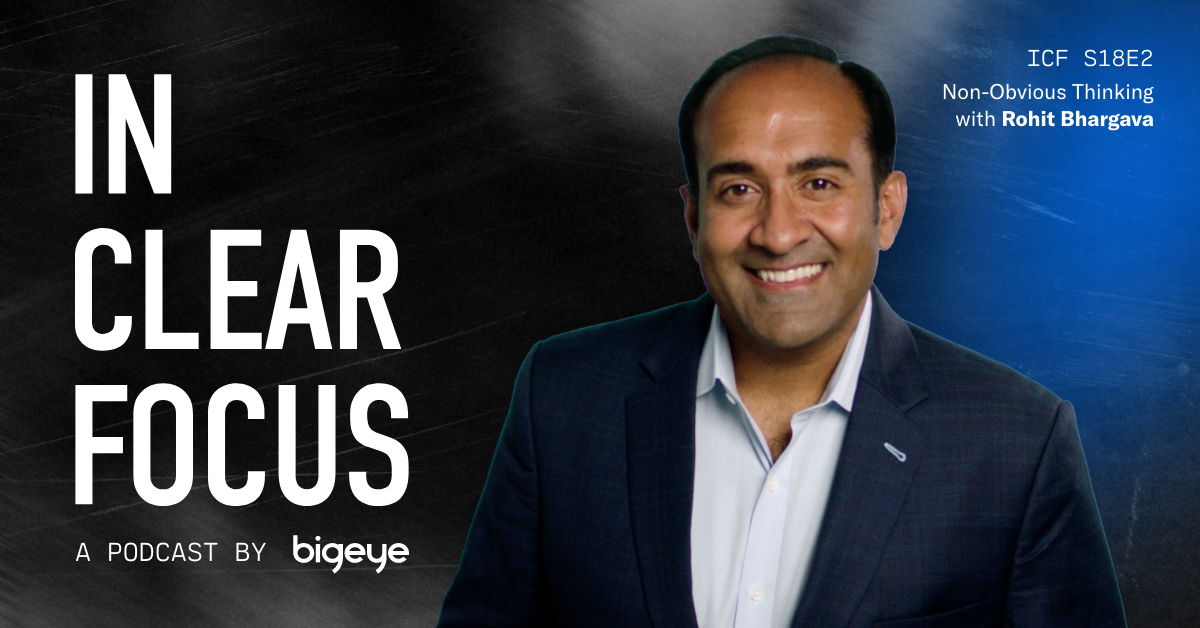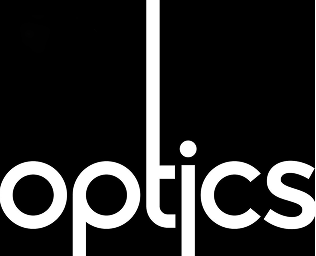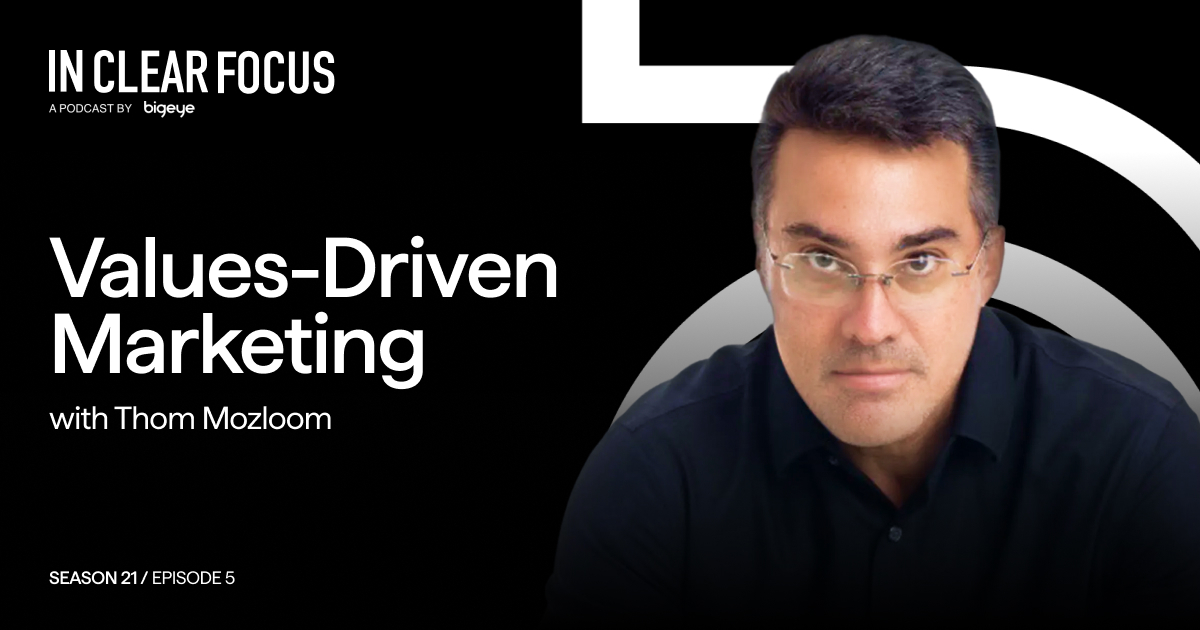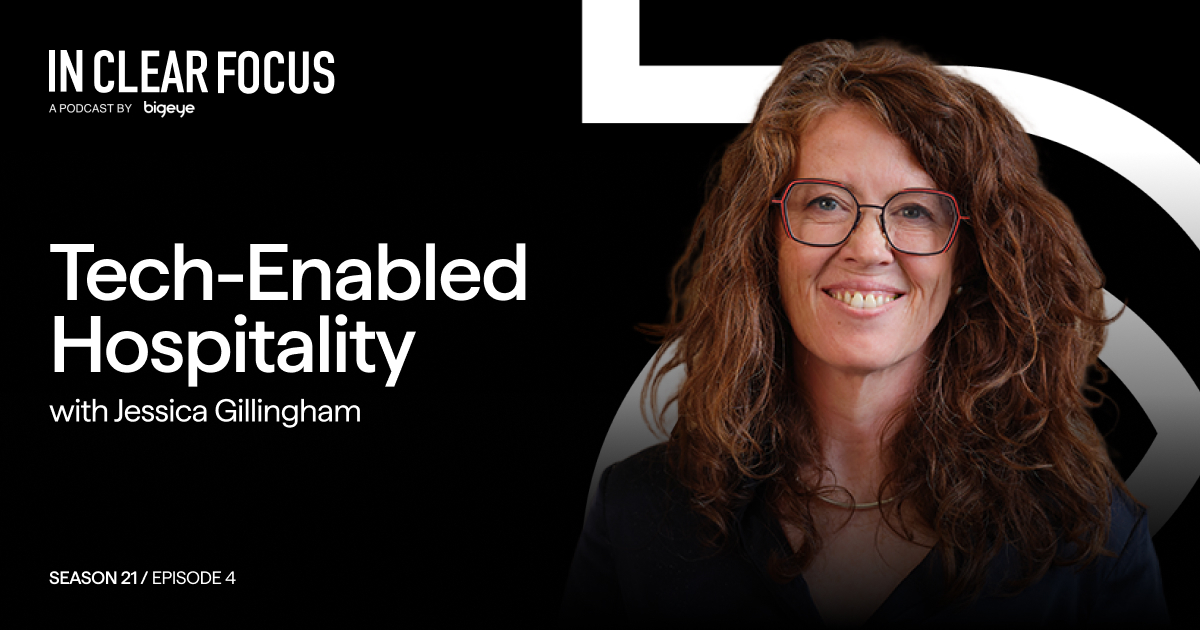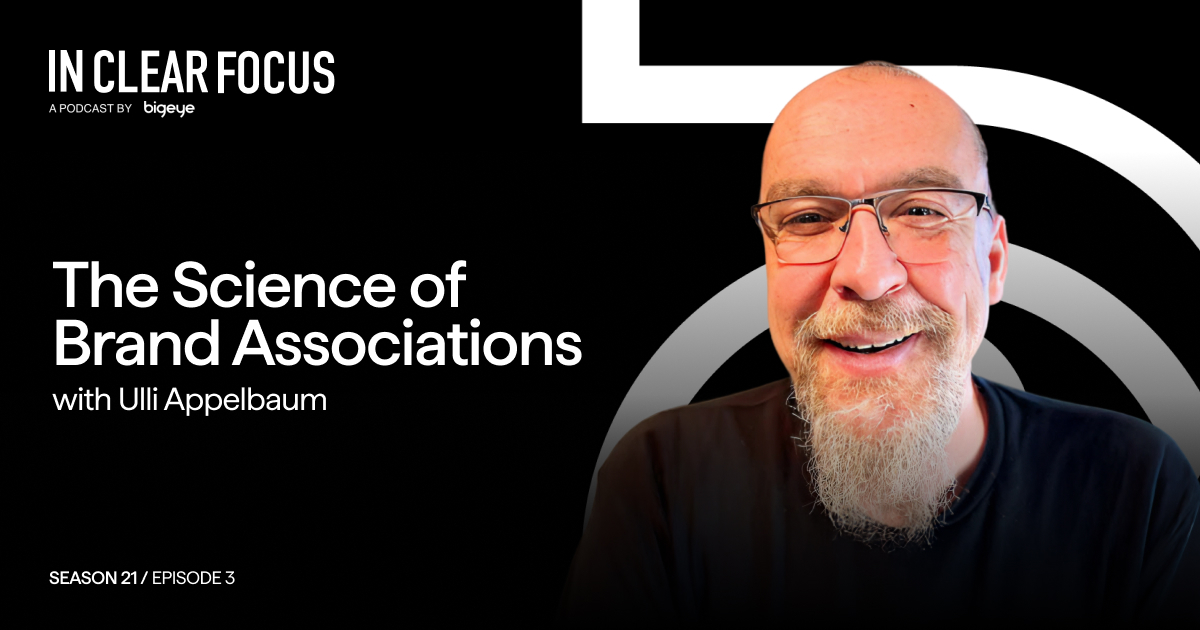IN CLEAR FOCUS: Marketing expert and futurist Rohit Bhargava makes a return appearance to discuss his latest book, “Non-Obvious Thinking: How to See What Others Miss.” Discover how Rohit’s SIFT framework (Space, Insights, Focus, Twist) uncovers hidden opportunities and innovative solutions. Rohit shares compelling examples of non-obvious thinking in action, from questioning map accuracy to leveraging AI in creative work, while offering practical strategies for seeing beyond conventional wisdom.
Episode Transcript
Adrian Tennant: Coming up in this episode of IN CLEAR FOCUS
Rohit Bhargava: Having a deeper, more personal conversation with someone is really what people want, but they don’t know how to get there. And asking better questions is the way to get there.
Adrian Tennant: You’re listening to IN CLEAR FOCUS, fresh perspectives on marketing and advertising produced weekly by Bigeye, a strategy-led full-service creative agency growing brands for clients globally. Hello, I’m your host, Adrian Tennant, Chief Strategy Officer. Thank you for joining us. Today’s fast-paced world often traps us in daily routines, making it difficult to imagine new perspectives or create truly original ideas. This is a problem not limited to marketers and advertisers. So what does it take to think bigger, have more empathy and transform our best ideas into reality? Well, our guest today believes he has the answer. Rohit Bhargava is a three-time Wall Street Journal and USA Today bestselling author who has dedicated his career to bringing more humanity to business. He’s a widely recognized expert in marketing, innovation, and trend forecasting. Rohit is the founder of The Non-Obvious Company, the co-founder of Idea Press Publishing, and serves as an adjunct professor at Georgetown University. Rohit has delivered keynote presentations in 32 countries, addressing audiences at organizations including NASA, Intel, Disney, and the World Bank, among many others. In March 2023, Rohit joined us on IN CLEAR FOCUS to discuss his book, “The Future Normal.” Today, he’s back to share insights from his latest work, “Non-Obvious Thinking: How to See What Others Miss,” co-authored with Ben DuPont. To discuss the book and some of its key ideas, I’m delighted that Rohit is joining us again from Washington, DC. Rohit, welcome back to IN CLEAR FOCUS!
Rohit Bhargava: Oh, thank you. I, too, am delighted to be back.
Adrian Tennant: For a decade, you published your “Non-Obvious Trends” series annually, spotlighting emerging ideas in business and popular culture. What inspired you to write “Non-Obvious Thinking” and shift your focus to the process of non-obvious thinking itself?
Rohit Bhargava: I think the biggest thing was just listening to what people wanted to hear. You know, it’s interesting. I mean, I spent a long time writing about trends. And to some degree, I did it because everyone wanted to know at the beginning of the year, “Well, what are the big hot trends,” right? And more and more, as I talked about trends in the future, people got really curious about the methodology behind it. Like, “How do you think in this way?” Like, “How do you see these things coming?” And more importantly, the second question is, “Do you have to have a certain type of role to do that? Or can anyone learn how to do it?” And so I took that question that I was increasingly being asked and said, “Could I create a framework to be able to allow people to see these new unusual ideas just in everyday life all the time and think in this way?”
Adrian Tennant: You co-authored “Non-Obvious Thinking” with venture capitalist Ben DuPont. I’m curious, how did you two first meet?
Rohit Bhargava: So it was quite by chance. I heard about Ben first because he had been organizing this dinner for nearly 20 years. And every year, he would bring people together once a year, and it would be probably 200, 300 people, so quite a large dinner. And he would challenge them to share their biggest idea for changing the world. And the dinner was actually called The Non-Obvious Dinner, which I didn’t know about until a friend of mine introduced me to it. And I thought, wow, he’s using “non-obvious.” I’ve got this brand and I’ve been using “non-obvious” for a long time. We need to put these pieces together. And so we had a call, and it just went amazingly well. And his perspective was really interesting and unique. And so we decided, you know, the timing’s right. Why not collaborate on what I’ve learned from using non-obvious thinking around trends in the future, and what he’s learned in terms of bringing these amazing big thinkers together to talk about their biggest idea to change the world every year?
Adrian Tennant: Well, this isn’t the first time that you’ve co-authored a book, and the last time you were on this podcast, we talked about “The Future Normal.” Could you tell us a little bit about your working partnership with Ben and what unique perspectives each of you brought to the project?
Rohit Bhargava: It’s interesting for me. This is the fourth book that I’ve done with a co-author and they’ve all been different co-authors. And the relationship is very unique and different depending on the different books that we’re writing together. For Ben and I, it was much more of a collaboration around the big ideas and what these pieces of the puzzle would be. And he’s a very big-picture sort of guy in terms of how he thinks about the world. And that was really nice for me because what it meant was that we could collaborate on these big ideas and concepts. But when it came to the writing and the writing style, I didn’t have to struggle too much to put two different pieces together because it was me doing kind of the writing piece of it because I’m the writer. And that was a great collaboration. It was quite different from what I did with Henry with “The Future Normal,” which you mentioned because both of us are writers, and both of us have these perspectives. And so in that book, It was very much a 50-50 in terms of the division of labor, but it was also a bit trickier because we had to put the voices of the two of us together. And he’s got this very beautiful British way of saying things, and I’ve got this much more crass, American direct way of saying things. And sometimes, that direct American way might be a little bit better, and sometimes the beautiful British way might be a little better. And so we kind of massaged those two to fit together as much as we could in the last book.
Adrian Tennant: Well, “Non-Obvious Thinking” introduces readers to the SIFT framework. That’s S-I-F-T. Rohit, could you explain what SIFT stands for and how you developed it?
Rohit Bhargava: Well, first of all, if you and your listeners don’t already know, I’m a marketing guy and so I love acronyms. I can’t help myself! And SIFT was sort of the perfect acronym because not only was it a four-letter way of describing the framework where each letter stands for something, but the word itself has a meaning. And SIFT means to sort through the noise and the chaos and find the things that are most meaningful, most valuable. And so SIFTing has its own meaning. And then SIFT as an acronym, we used it to stand for. The ‘S’ was Space. So create more space for new ideas. The ‘I’ was Insights. So identify kind of big concepts and put those pieces together. The ‘F’ was Focus. So focus your attention on what really matters. And the ‘T’ was Twist. And this is where the non-obvious came into it, because when you put these pieces together, if you can find an idea or a way of saying things that is a bit of a twist on what has been out there before, then you can come to something really unique in terms of perspective.
Adrian Tennant: Got it. You provide some fascinating examples in the book, from termite mounds in Zimbabwe to a previously undiscovered Australian island. Could you share one or two of your favorite stories that you think exemplify non-obvious thinking?
Rohit Bhargava: Yeah, the Australian island one is a particularly interesting one. I mean, I spent five years living in Australia and so I had a kind of personal attraction to this story, but it’s really interesting. So, we think that we live in a world that has been mapped to the nth degree, right? We have GPS, we can locate ourselves in lots of different areas of the world. We have maps that allow us to go from one place to the other without getting lost if we choose. And there was a story of this island called Sandy Island that was on all maps. It was on physical maps. It was on Google Maps. And some researchers in Australia said, “Well, let’s go find this Sandy Island,” in 2012. So, you know, just a decade ago, I mean, really within most of our lifetimes, really. And when they visited that area, they found that there was nothing there. And it turned out that that island had been mapped at some point and then relayed over to Google Maps, but never actually checked. And once they actually checked it and found that it didn’t exist, they undiscovered it, which I love as a term, right? Because we talk about discovery, but not undiscovery as in, you know, finding something that’s wrong. And it was this beautiful example of the reminder that though we think that everything may be mapped out and there’s nothing left to discover, sometimes there are things left to undiscover. And to me, that’s such a perfect example of non-obvious thinking because it’s this flip twist of the thing we all know.
Adrian Tennant: Well, I reviewed the book, as you know, and the SIFT framework seems very practical. Could you walk us through how someone might apply it to a real-world business challenge?
Rohit Bhargava: You could name any challenge, right? And as you are thinking about it, so let’s say that you have a business challenge of expansion, which is very common, right? You have whatever business you have, you want more business. Now you’ve got to think about how you’re going to do that. Well, the first step of the method would be space. And this is creating physical and mental space for yourself. So there’s no way to solve a new challenge if you don’t give yourself some room to come up with new ideas and to appreciate new perspectives. So space is all about doing that. Insight is about trying to come up with some sort of a new way of approaching or thinking about it. So, for example, if you’re thinking about expansion, well, who are your competitors? What are they doing? What is the thing that they are all focused on? Are they all focused on the same thing? Could you focus on something a little bit different? Could you reach a different sort of audience than what others have reached? Could you expand your market? These are all kind of opportunities for some sort of insight. Focus is, all right, now you’ve come up with many different things. We’ve all been in those moments where you have the brainstorm, where you come up with eight ideas that could be great, but you don’t know which one to focus on. So focus is all about kind of narrowing that down, getting to those main core ideas to say, well, for example, if we want to expand our business and we want to get more business, then perhaps we are choosing to focus on who could we sell to that we haven’t sold to before. Okay. Now you get to the last piece, which is twist. What is the twist that will allow you to do that? What is the idea, the creative way to allow you to do that, that will stand out and that will achieve the goals that you’re trying to accomplish?
Adrian Tennant: In “Non-Obvious Thinking,” you state that discovering insights usually starts by asking better questions. Can you share specific techniques for asking better questions that anyone can use?
Rohit Bhargava: Yeah, I think that part of it comes down to really trying to get behind the emotion of what something was or how someone felt. And doing it in a way that doesn’t feel invasive or creepy is a skill, right? And it’s something that you’ll really need to practice. And great interviewers manage to find a way to do that without making someone feel like they’re on the spot. It’s not a good experience when someone does feel like they’re on the spot, you know? So trying to do it in a gentle way is really important and that takes practice. But ultimately, what you’re trying to do is you’re trying to get someone to tell you the piece of that story or bring out that element of the story that helps you connect with them as a person. And this is not just for like, okay, you’re interviewing somebody like as part of a podcast. I’m talking about like just having a great conversation with someone at a party, you know, on a date, wherever, right? I mean, there’s many situations – a job interview. I mean, there’s lots of situations where having a deeper, more personal conversation with someone is really what people want, but they don’t know how to get there. And asking better questions is the way to get there.
Adrian Tennant: Perfect. Rohit, I remember when we discussed the writing process for “The Future Normal,” you shared with me that you used AI in interesting ways, like having it critique chapters and even suggest ideas for illustrations, not the illustrations themselves, I should point out. Did you employ AI tools similarly while writing non-obvious thinking?
Rohit Bhargava: We did. So we did very much the same sort of methods to some degree. I mean, we did have it read early versions of chapters and suggest ideas. One of the things that this book had is very practical applications. So we’ll talk about an idea in a chapter, and then we’ll give you like two suggestions, two tips for how to put that into action. Sometimes you get to this point, and you might have had this at some point when you’re writing something and you’re like, “Okay, this is the thing we want to do, and here’s the tip, and now we need a second tip, and we’re not exactly sure what that second tip should be.” And it’s really tough and you stare at the screen and it’s just not coming. So in this case, we could use generative AI to say, “Here’s the chapter, here’s the theme, here’s one tip, suggest a possible second tip.” And now you get a bunch of different suggestions and maybe one of those suggestions is the nugget that leads to what that second tip would be. So the last book, “[The] Future Normal,” had icons. So, each trend had an icon, and we used generative AI to suggest what that icon could be. This book has illustrations throughout the book. So similarly, we used it to think about, “Well, what could those illustrations be?” This one was actually even more fun because unlike “[The] Future Normal,”, where we had icons and we had created some, but we found some that existed, these were all hand-drawn illustrations. So now we could come up with any idea, go to our illustrator and say, “What about this? Can you mock this up? What would this look like?” And then it could become this whole back-and-forth collaboration between an actual human illustrator based on some ideas that we generated using AI sometimes.
Adrian Tennant: Love that. Well, we’re all familiar with the reviews on the back of books – or the “blurbs,” as I believe they’re known in the trade. You marketed “Non-Obvious Thinking” in a really innovative way by running a contest for one-word reviews. Rohit, what inspired this approach, and what was the response like?
Rohit Bhargava: Well, the response was stellar. And in fact, you had a particularly stellar response, which was our winner and made it onto the back! And the fun part of this was we had all of these people who wrote these one-word book reviews. Yours was “Sagacious!” Excellent word.
Adrian Tennant: Thank you.
Rohit Bhargava: And what we did with these one-word reviews is that we published them through social media, and we started sharing them. And then we also went back to all of the people who had written these one-word reviews and invited them to take that review and turn it into an Amazon review, which is, as any person who’s written a book knows, one of the biggest challenges from an activity point-of-view to get people to follow through and do write these book reviews. So part of it was “Let’s encourage people to write these reviews, let’s have a fun game, and let’s create a meaningful win for people that comes from that.” And it really got a lot of buzz and the response was amazing.
Adrian Tennant: It’s the only time in my life I’m going to be surrounded by those names on a blurb, so I loved it. Thank you for selecting my entry.
Rohit Bhargava: Yeah, you’re right there, along with Dan Pink and Adam Grant and Tony Robbins and Sal Khan from the Khan Academy. I mean, you’re in good company – and they’re in good company too!
Adrian Tennant: I may have shared it excessively on LinkedIn, just saying.
Rohit Bhargava: As you should.
Adrian Tennant: Thank you. Rohit, what kind of feedback have you and Ben received from readers about “Non-Obvious Thinking”?
Rohit Bhargava: I mean, we received a lot of feedback, which is always really nice. And sometimes the feedback is, “Love the book!” And things like that, which make you feel good, but they’re not particularly detailed. One of the pieces of feedback that I heard multiple times, which I think means that it’s probably true, is that a lot of people said, “I don’t read books, and I definitely don’t read business books, but I read this one.” And to me, that was really gratifying because what it meant was that we could open up this genre and world of books in a way that felt approachable to people who are intimidated sometimes by books because they get a book that feels really long and “Oh, I don’t know if I have time for this” and “Am I going to be able to focus on it, especially when I’m used to like seven-second videos on TikTok or Instagram or social media?” And this book has very short chapters. It has stories. It’s fully illustrated. Like I said, I mean, it’s very easy for anyone to just jump in, read a bit of it, get something useful, put it down. I mean, you could read the whole thing probably on a two-hour flight, maybe not even two hours. So it’s very approachable in that way. It made us really happy to hear that that was how people experienced it because that’s what we wanted.
Adrian Tennant: Let’s take a short break. We’ll be right back after this message.
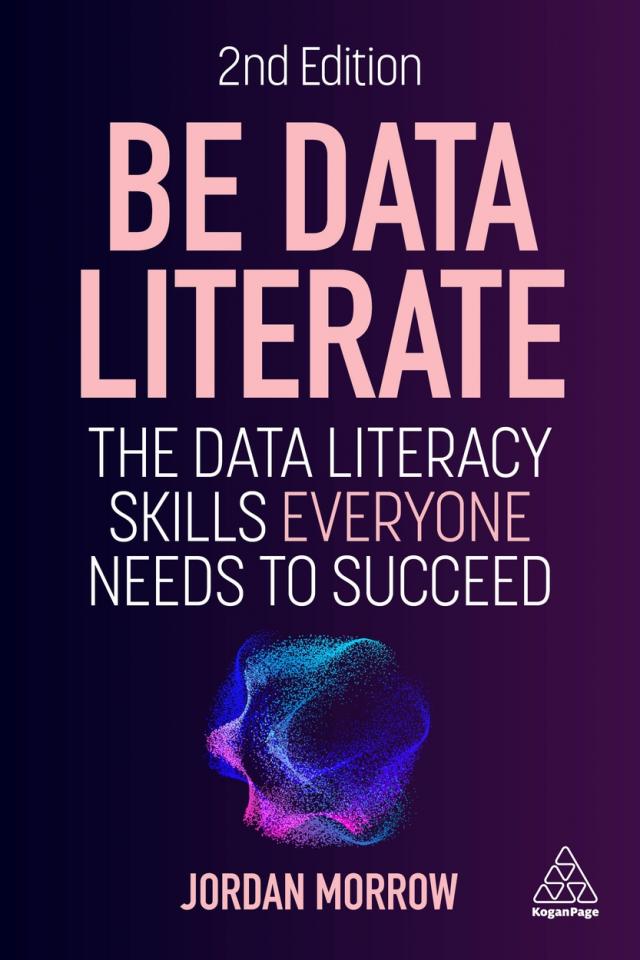 |
Adrian Tennant: In partnership with our friends at Kogan Page, January’s Bigeye Book Club selection is “Be Data Literate: The Data Literacy Skills Everyone Needs To Succeed.” Author Jordan Morrow presents a practical guide for developing curiosity, creativity, and critical thinking to become data literate without requiring a data science degree. Through real-world examples and practical insights, Be Data Literate explains how to master analytics. As an IN CLEAR FOCUS listener, you can save 25 percent on Be Data Literate when you order directly from the publisher at KoganPage.com. Just enter the exclusive promo code BIGEYE25 at checkout. Shipping is always complimentary for customers in the US and the UK. Be Data Literate is your guide to thriving with data-driven marketing and advertising. |
Adrian Tennant: Welcome back.
I’m talking with Rohit Bhargava, founder of The Non-Obvious Company and co-author of “Non-Obvious Thinking: How to See What Others Miss.” The Non-Obvious Book Awards were announced in December 2024. Rohit, can you tell us about the awards and what differentiates them from other book awards?
Rohit Bhargava: Yeah, so what was interesting is when I started IdeaPress, I was a writer before, and I was an author before, but I became a student of books and publishing once I started a publishing company. And what that meant was not just looking at whether the book reads well or whether it has a nice cover, but you know, what’s the headband on the book? Like, how are they printing it? What sort of spot UV glosses are they using? I mean, all of the details of that. And then what does the metadata say? How does the book go out into market? Is it doing well over here? Like, how is it doing in performance versus the other books in its category? I mean, all these things that you think about when you get into publishing that help you if you think about them as an author, right? But most authors don’t. And for me, what that led me to was, “Well, I always love books. I always love evaluating books and I read a lot of books. What if I could create an awards program that celebrated business books?” Which first of all, there are just aren’t that many that do that. And the ones that do oftentimes tend to be for profit awards programs. So you pay to submit your book and then they get X number of submissions, and that’s their budget. Right? And so I launched the Non-Obvious Book Awards as a way of celebrating the most interesting, fascinating business books. And not charging. So there’s no awards entry fee. All you have to do is send two physical copies of the book. I didn’t want anyone who could just slap a book up on Kindle quickly or doing those types of books to be able to enter. So I said, you have to have a physical book. That’s the requirement. So if you don’t have your book in print form or you can’t do a print on demand, not eligible. And it has to have been published in the last year. So we’ll do it annually. And other than that, we did not put the parameters on it that a lot of other book awards do such as like categories, because I’ve always thought if a book is like a great sales book, maybe it’s also a leadership book. So, what category do you put it in? Do you put it in leadership? Do you put it in sales? And are people really buying books like that way? I mean, yeah, maybe you’re looking for a book that says something about sales, but you’re also looking for like something that speaks to you based on the challenges that you have. And sometimes, they don’t fit into those neat little categories. So that was the Non-Obvious Book Awards. And we started getting first like several dozen, then we got several hundred submissions. Now we get more than a thousand submissions every year.
Adrian Tennant: Wow.
Rohit Bhargava: And so it’s huge. I mean, I, I struggle a little bit with the physical, you know, number of books that we get coming into our post office box that we then have to like, you know, unwrap and evaluate and send out to various judges. And so, I mean, it is quite a undertaking. But we love it. And every year we publish the new version of the list. Last year we did a partnership with Inc. Magazine. This year we have new partnerships with new media platforms coming. So we’re really bringing more visibility to these books. And the whole idea is that I believe people should be reading more books and more business books specifically. And business books are routinely underappreciated. And part of the goal of this program is to bring them to more people.
Adrian Tennant: Well done! Readers of your weekly newsletter received a very nice bonus. In the December newsletter, you released a free audiobook version of “Non-Obvious Thinking.” What was the thinking behind that decision? And Rohit, why did you avoid Audible.com?
Rohit Bhargava: So, the second answer is easy. Audible.com is a terrible platform in terms of how it exploits authors and publishers. And I’m not the only one who shares this perspective. There’s many others who do. So, if you just care about convenience, sure, go and maybe get a book on Audible. But if you actually care what an author and publisher gets paid, there’s no way you should be listening to books on Audible. You can get them on Spotify, Apple, Google, and there’s a ton of other platforms as well that we’re experimenting with. And so, you know, please go and get your audiobook anywhere but audible is my plea to you as an author and a publisher. But that’s why we avoided it. Well, I chose to avoid it for my book. Now, we do as a publisher, we do publish other books of ours on Audible because that’s the author’s choice to do that. But I personally will not be publishing any more books on Audible. I think that the amount of money that they take and the control that they have and the lack of ability for us to make any meaningful money on it means that it’s just not a good business choice. So unless things change moving forward, I’m not planning on putting any more books on Audible of mine.
Adrian Tennant: Very clear. Thank you, sir. In case we were in any doubt about your perspective on Audible.com!
Rohit Bhargava: Yeah. I mean, I probably could sugarcoat it, but that’s not my perspective or personality. You know, like if I see something and I feel like it’s a total exploitation, like that’s what I’m going to say. I don’t work for a large company where somebody has lawyers that say, you shouldn’t say that.
Adrian Tennant: Well, you alluded to your time in Australia in the earlier part of your career when you were working in strategy and planning, of course. Now, you’ve observed that when people share stories, they often include tiny details that feel unimportant to them. Rohit, how can we learn to recognize those details that may lead us to an insight? Asking for a friend, of course.
Rohit Bhargava: Well, I think that part of it is listening to someone’s tone. And sometimes when they’re talking about a story, and they’re setting up something, there’s some detail that they might recollect about a smell or something that was in the background, or they might say something like, “You know, again, we had done something like this …” right? Which indicates that there was a first time for that thing. So, as you start to interview people, I think that you can get better at listening for those types of what are sometimes called “throwaway details.” The things that they don’t think are important for the story, but actually do really set up how they got to their perspective. So, for example, if I was interviewing someone and I said, “Well, how did you get your start?” They might say, “Well, you know, I struggled for years, and I made a lot of mistakes, but then I finally found my way in advertising, and I got to this thing.” And I would then go back and say, “Wait, wait, wait, you struggled for a lot of years. You made mistakes. Like what was one of the mistakes you made?” Right. Because they’re skipping over that to get to what they think is really important, which is the thing that they found that they’re great at doing. But sometimes there’s some really interesting learnings from that thing that they just quickly went past.
Adrian Tennant: Rohit, you recently attended CES 2025 in Las Vegas. So, what were some of your non-obvious observations from the show?
Rohit Bhargava: Well, so for anyone who doesn’t know, the CES, the Consumer Electronics Show, is a huge trade show. It attracts like hundreds of thousands of people that come to Las Vegas from all aspects of the tech community. So you’ll have people there launching software, you’ll have people there creating digital cameras, AI-enabled bulldozers that are literally on display there, and you can stand next to one of these huge bulldozers and tractors. They have a little bit of all of those things. And so what I usually look for when I’m there is what are the innovations that are moving us forward that are likely to be the next thing? And then who are the people behind these innovations that are creating really interesting applications? So I met one entrepreneur, for example, who was working on a genetically enhanced houseplant that would purify the air 30 times more effectively than any other houseplant.
Adrian Tennant: Wow.
Rohit Bhargava: And that itself is cool, but they had that last year, and you could buy the plant. This year, they launched a series of powdered drops that you could mix with water and put into any house plant to convert that house plant into a plant that purifies the air 30 times more. So that’s the evolution of some of these things. It’s really interesting to see like, what was it last year? What is it this year? How is it moving forward? And you know, how is it going to be mainstream, right? I mean, some of the most obvious things, like I went to CES for years and one of the most obvious things to me seemed like a robot pool cleaner. No big deal. But a lot of people are like, “Well, that sounds pretty awesome.” Especially if they have a pool and they don’t have a robotic pool cleaner that could go through and test your water quality and clean the pool. And you wouldn’t have to take one of those big scoop things to like scoop out leaves and stuff from your pool. So if I had a pool, that seems like it would be pretty awesome. And so that’s the thing that you start to see and uncover when you go to a show like CES. What are these things that are hugely futuristic, like the flying copter or whatever it is, and what are the things that are just kind of the future that will probably be common, right? I mean, people are not that impressed by robot vacuum cleaners now. They used to be. Maybe the next thing is robot pool cleaners.
Adrian Tennant: Looking ahead, what projects are you working on for 2025?
Rohit Bhargava: 2025 is going to be a really fun year for us because, first of all, as a publisher, we’re expanding and taking on more authors doing more interesting work, which is great and really fulfilling. There’s more online video content that we’re creating to try and showcase interesting, fascinating, non-obvious things. And then I’ve just got a personal mission that I’m going to try and accelerate in 2025 to be more of a convener of people, to bring interesting people together, to connect them with one another, oftentimes in real life. So I’m lucky, I get to go to probably 40 events a year and speak. And at those events, one of my goals is not just to be a great speaker on stage, but also to be someone who makes connections happen in real life between people. So at a lot of these events, we’re going to start doing our seven-minute meetup, which is a really fun signature event where I bring people together for seven minutes, as the title suggests, and I teach them a better way to network with one another and get to know each other like we were talking about before on a deeper level in a short period of time by asking some very specific questions and then using a specific technique to be able to get better at the one thing that all of us know we should do but generally hate to do, which is networking.
Adrian Tennant: If IN CLEAR FOCUS listeners would like to learn more about “Non-Obvious Thinking,” or your other work, what’s the best way to do so?
Rohit Bhargava: Just NonObvious.com to get the whole access to everything non-obvious like my newsletter, podcast, books, all of that. My personal site, if you want to watch videos and just interact with me, is just my full name, so RohitBhargava.com.
Adrian Tennant: Got it. Rohit, thank you very much for being our guest again on IN CLEAR FOCUS.
Rohit Bhargava: Thank you. Thanks for having me.
Adrian Tennant: Thanks again to my guest this week, Rohit Bhargava, co-author of “Non-Obvious Thinking, How to See What Others Miss.” As always, you’ll find a complete transcript of our conversation with timestamps and links to the resources we discussed on the IN CLEAR FOCUS page at bigeyeagency.com. Just select ‘Insights’ from the menu. Thank you for listening to IN CLEAR FOCUS, produced by Bigeye. I’ve been your host, Adrian Tennant. Until next week, goodbye.
TIMESTAMPS
00:00: Introduction to “Non-Obvious Thinking”
00:24: Meet Rohit Bhargava
01:08: From Trends to Thinking
01:32: Collaboration with Ben DuPont
02:28: The SIFT Framework Explained
06:05: Examples of Non-Obvious Thinking
09:14: Applying SIFT to Business Challenges
11:02: Asking Better Questions
12:19: Using AI in the Writing Process
14:44: Innovative Marketing Strategies
16:13: Reader Feedback on “Non-Obvious Thinking”
18:31: The Non-Obvious Book Awards
21:55: Free Audiobook Release
22:14: Critique of Audible.com
23:43: Recognizing Insightful Details in Stories
25:32: Observations from CES 2025
27:56: Looking Ahead to 2025 Projects
29:19: Where to Learn More
29:45: Closing Remarks
